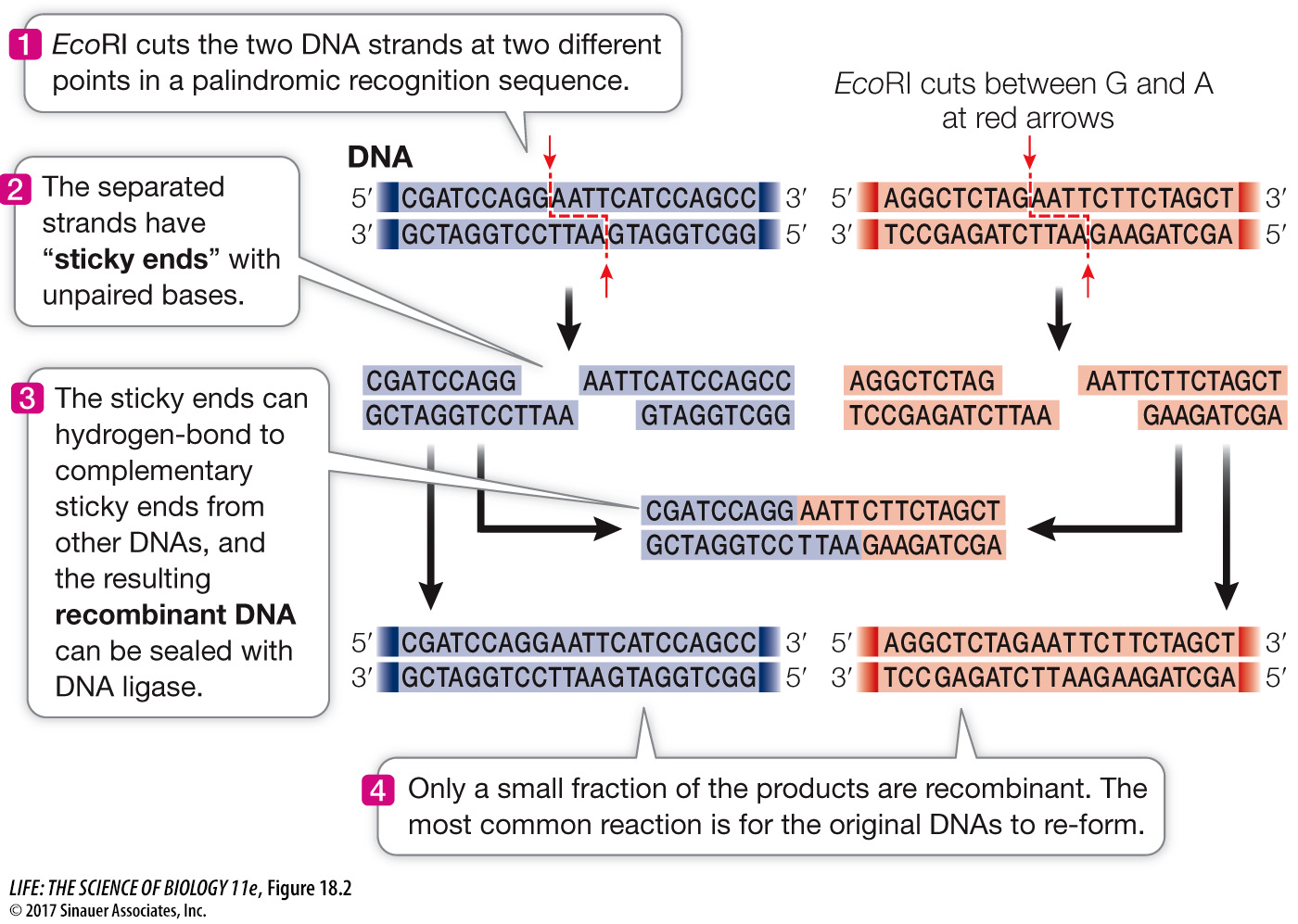key concept 18.1 DNA from Different Sources Forms Recombinant DNA
Recombinant DNA is a DNA molecule that has been made in the laboratory using at least two different sources of DNA. The DNAs used for recombination can be from the same organism (e.g., from different chromosomes), from different members of the same species, or from entirely different organisms.
Recombinant DNA technology uses restriction enzymes and DNA ligase to respectively cut and paste DNA.
Restriction enzymes (*restriction endonucleases) can cleave double-stranded DNA. In the late 1960s scientists discovered DNA ligase, which catalyzes the joining of DNA fragments; one of its functions is to join Okazaki fragments during DNA replication (see Figure 13.15). With restriction enzymes in hand, scientists saw the potential to cut DNA molecules and then splice the fragments together in new combinations (“recombine” the DNA fragments). In 1973 Stanley Cohen at Stanford University, Herbert Boyer at the University of California, and their colleagues did just that. As illustrated in Figure 18.1, they isolated two different plasmids (small circular DNA molecules that replicate independently of the main chromosome in bacterial cells; see Figure 12.22) from Escherichia coli. Each of the two plasmids contained different antibiotic resistance genes. The scientists cut the two plasmids with restriction enzymes, mixed the fragments together, and then used DNA ligase to rejoin them. The recombinant plasmids of this ligation reaction were then inserted into new E. coli cells, and the cells were grown in the presence of both antibiotics. A few of the bacteria had been transformed with a recombinant plasmid containing both of the antibiotic resistance genes and could grow on the medium, whereas no E. coli lacking a recombinant plasmid were resistant to both antibiotics. With this experiment, recombinant DNA technology was born.
*connect the concepts As discussed in Key Concept 15.3, restriction endonucleases are a class of enzymes that cut DNA molecules. Each enzyme recognizes a unique sequence of nucleotides in the DNA strand, usually about 4–6 base pairs long.
experiment
Figure 18.1 Can DNA from Two Different Sources Be Recombined into a Single Functional DNA Molecule?
Original Paper: Cohen, S. N., A. C. Y. Chang, H. W. Boyer and R. B. Helling. 1973. Construction of biologically functional bacterial plasmids in vitro. Proceedings of the National Academy of Sciences USA 70: 3240–3244.
With the discovery of restriction enzymes and DNA ligase, it became possible to combine DNA fragments from different sources in the laboratory. But would such “recombinant DNA” be functional when inserted into a living cell? The results of this experiment by Stanley Cohen and Herbert Boyer completely changed the scope of genetic research, increasing our knowledge of gene structure and function, and ushered in the new field of biotechnology.
Media Clip 18.1 Striking Views of Recombinant DNA Being Made
A work with the data exercise that accompanies this figure may be assigned in LaunchPad
Let’s look more closely at what happens when DNA is cut with a restriction enzyme and then rejoined with DNA ligase. Many restriction enzymes recognize palindromic DNA sequences—sequences that read the same way in both directions. For example, you can read the DNA recognition sequence for the restriction enzyme EcoRI from 5′ to 3′ as GAATTC on both strands:
Some restriction enzymes cut the DNA straight through the middle of the palindrome, generating “blunt-ended” fragments. Others, such as EcoRI, make staggered cuts—they cut the phosphodiester bond of one strand of the double helix several bases away from where they cut the other (Focus: Key Figure 18.2). After EcoRI makes its two cuts in the complementary strands, the ends of the strands are held together only by the hydrogen bonds between four base pairs. At warm temperatures (above room temperature) these hydrogen bonds are too weak to hold the two strands together, so the DNA separates into fragments when it is warmed. Each fragment carries a single-stranded “overhang” at the location of each cut. These overhangs are called sticky ends because they have specific base sequences that can bind by base pairing with complementary sticky ends.
focus: key figure

Figure 18.2 Cutting, Splicing, and Joining DNA Some restriction enzymes (EcoRI is shown here) make staggered cuts in DNA. EcoRI can be used to cut two different DNA molecules (blue and orange). The exposed bases can hydrogen-bond with complementary exposed bases on other DNA fragments, forming recombinant DNA. DNA ligase stabilizes the recombinant molecule by forming covalent bonds in the DNA backbone.
Question
Q: If restriction enzymes make blunt (non-sticky) ends in DNA, how can two DNA molecules be spliced together?
DNA ligase is needed for the formation of strong covalent bonds to link the DNAs.
Any two sticky ends that are complementary can form hydrogen bonds with one another. The sticky ends of the original molecule may rejoin, or two different fragments may join (see Figure 18.2). Indeed, a fragment from one source, such as a human, can be joined to a fragment from another source, such as a bacterium. Initially the fragments are held together only by weak hydrogen bonds, but the enzyme DNA ligase catalyzes the formation of covalent bonds between adjacent nucleotides at the ends of the fragments, joining them to form a single, larger molecule.
Besides EcoRI, there are hundreds of other restriction enzymes, each with its own recognition sequence. With these tools—restriction enzymes and DNA ligase—scientists can cut and rejoin different DNA molecules from any sources, including artificially synthesized DNA sequences. Recently, new tools have been developed for making recombinant DNA. Methods based on the polymerase chain reaction (PCR) allow the joining of any two DNA molecules without the need for conveniently placed restriction enzyme sites. Despite these advances, restriction enzymes and DNA ligase are still used routinely for recombinant DNA construction in biology labs.

